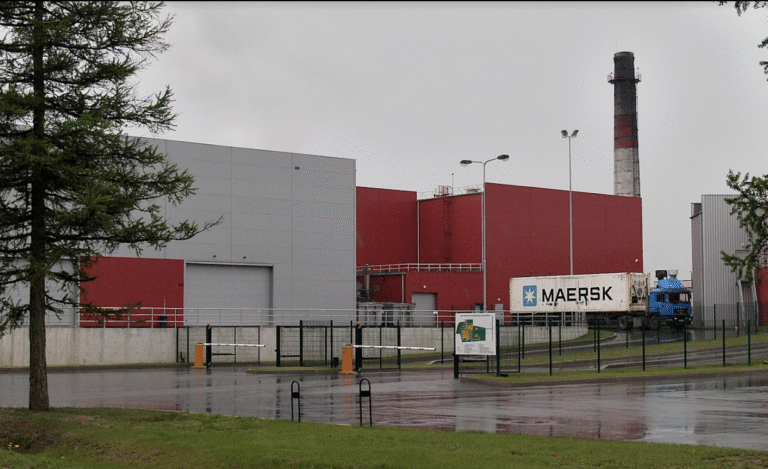Home > Products > Pressure sensors
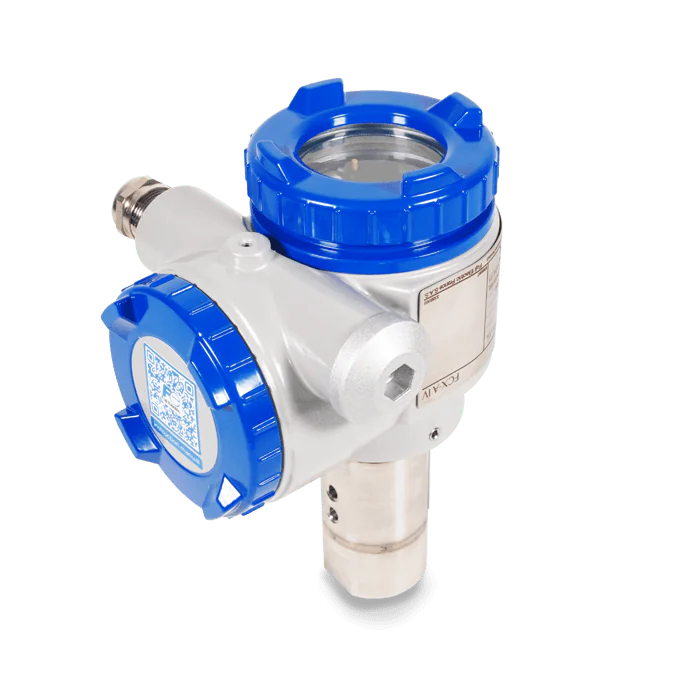
Pressure sensors
Pressure sensors are devices designed to measure pressure in gases, liquids, air, or oil. Pressure transmitters are widely used in various industrial processes, such as filtration systems, chemical feed systems, wastewater industry, food industry, pump stations, and more.
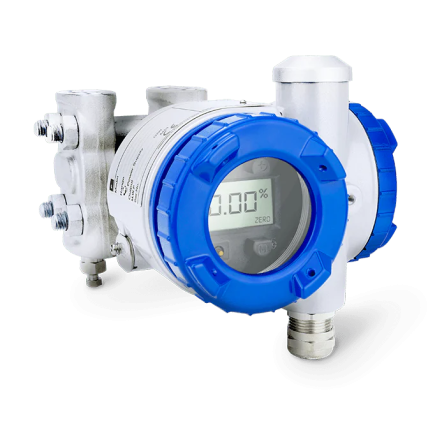
Measures
Diaphragm seals

Pressure sensors
Fuji Electric differential pressure sensor – FKC
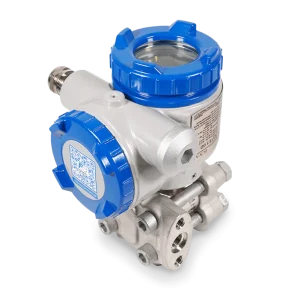
Pressure sensors
Fuji Electric gauge pressure transmitter – FKG

Pressure sensors
Fuji Electric absolute pressure sensor – FKA
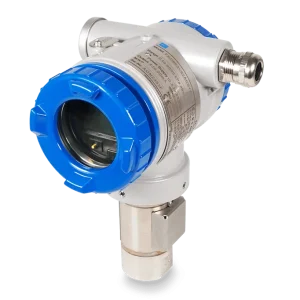
Pressure sensors
Fuji Electric absolute pressure sensor – FKH

Pressure sensors
Fuji Electric manometric pressure sensor – FKP

Pressure sensors
Fuji Electric pressure sensor – FKE
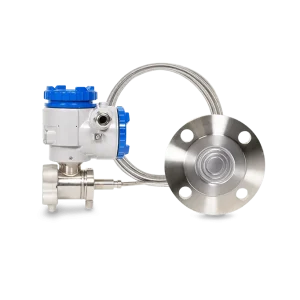
Pressure sensors
Fuji Electric pressure sensor with diaphragm seal – FKB
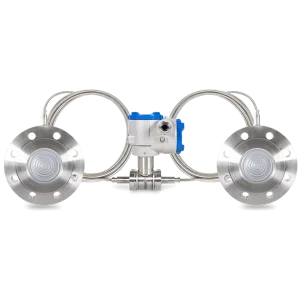
Pressure sensors
Fuji Electric differential pressure sensor with seal – FKD
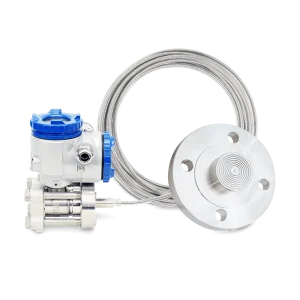
Pressure sensors
Fuji Electric absolute pressure sensor with seal – FKM
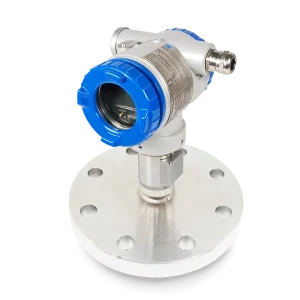
Pressure sensors
Fuji Electric absolute pressure sensor with seal – FKH F
The highest quality of every product
Local support in your country
Customer service every step of the way
Smooth technical communication
Pressure Sensor Buying Guide
Pressure transmitters are indispensable in various industrial and technological fields.
In this guide, you will learn what a pressure transmitter is, how it works, and how pressure measurement originates—from its fundamental units to the advantages and disadvantages of different types of sensors.
We will also cover the composition of a pressure transmitter, the types of output signals, and the key criteria for selecting an industrial pressure transmitter. Additionally, we will examine different categories of pressure transmitters, including differential, absolute, and gauge pressure sensors, along with practical advice on their calibration, installation, and testing.
Finally, we will review the configuration of a pressure transmitter and its practical applications in the field, evaluating its benefits and limitations.
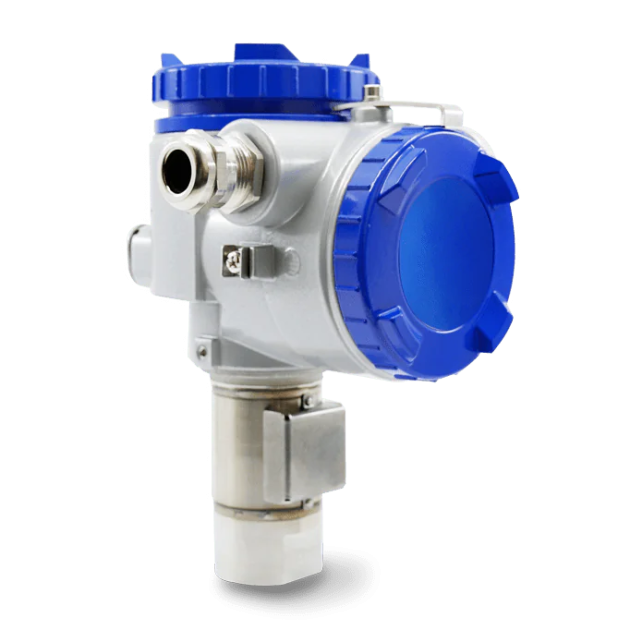

The Origin of Pressure Measurement
The Pascal unit of measurement is named after the famous French philosopher, physicist, and mathematician Blaise Pascal.
Born in Clermont-Ferrand, where the production unit of the French pressure transmitter manufacturer Fuji Electric France SAS is located, Pascal conducted a fundamental experiment by transporting a barometer to the summit of Puy de Dôme to demonstrate that atmospheric pressure decreases with altitude above sea level.
However, it was the Italian scientist Evangelista Torricelli who was the first to prove the pressure exerted by the mass of air on Earth and to develop the first mercury barometer.
Pressure Measurement Unit
The first factor, p, is expressed in terms of force F per unit area A:p = F / A Understanding pressure units and their conversion is essential for correctly selecting the scale of an industrial pressure transmitter.
- Pascal (Pa): The base unit of pressure in the International System of Units (SI). One pascal is equal to 1 Newton per square meter (1 Pa = 1 N/m²).
- Bar (Bar): A commonly used pressure measurement unit in industry. One bar is equivalent to 100,000 Pa.
- Standard Atmosphere (atm): Used to express barometric or atmospheric pressure. One atmosphere is equal to 101,325 Pa.

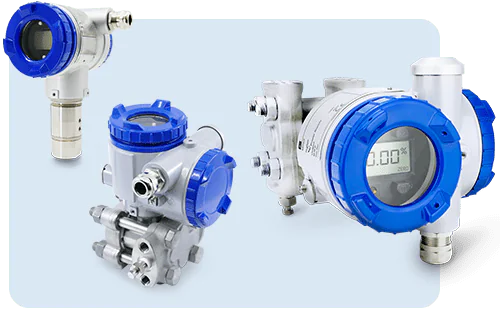
What is a Pressure Transmitter?
A pressure transmitter is also known as a pressure sensor, pressure gauge, or pressure transducer. There is no fundamental difference between these terms, but a distinction can be made between standard pressure transducers and smart pressure transducers.
Based on the definition of a pressure transmitter, it is a pressure sensor that operates by converting the force exerted by fluid pressure on a specific surface (deformation) into an electrical signal.
Industrial companies use pressure transmitters for:
- Measuring pressure with a relative or absolute pressure transmitter.
- Flow measurement using a pressure reduction device and a differential pressure transmitter.
- Level measurement with a hydrostatic pressure transmitter.
- Density measurement using a differential pressure transmitter.
What is the operating principle of a pressure sensor?
The pressure of the liquid, through the connection and mechanical interface – a measurement membrane made of stainless steel, ceramic, or another noble material – acts on the internal measuring component.
The electronic measuring element converts the pressure into a raw output signal.

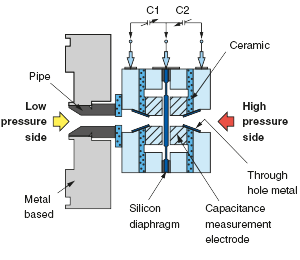
How Does a Pressure Transmitter Work?
The technologies, methods, approaches, and measurement principles of pressure transmitter models vary, each designed for specific needs in process automation and industrial applications.
- A piezoresistive pressure sensor measures the force acting on a metallic membrane. When stress is applied to a thin film, it deforms, and the pressure change is transmitted through an incompressible fluid (oil or water). As a result, the piezoresistive silicon element (a Wheatstone bridge circuit) deforms. This element, utilizing semiconductors, acts as a variable electrical resistor that converts deformation into an ohmic value. Some of these sensors also incorporate MEMS (microelectromechanical systems), ensuring miniaturization and increased sensitivity.
- The capacitive sensor of the pressure transmitter measures the force exerted on a stainless steel or ceramic-metal diaphragm. When pressure is applied, the metal membrane deforms, transmitting the pressure change through an intermediate incompressible fluid (oil or water). This deformation affects the capacitive silicon element, which acts as a variable capacitor that converts deformation into a capacitance value.
- In a frequency resonance transmitter, specific terms such as BFSL (Best Fit Straight Line) are used to define measurement linearity. This type of pressure transmitter converts pressure variations into frequency changes, offering high resolution and various solutions for different applications.
- The strain gauge or tension sensor of the pressure transmitter operates similarly—the sensor's output signal is filtered, amplified, temperature-compensated, and formatted into an analog signal. The analog output is transmitted via an electrical connection, reducing errors and increasing accuracy.
- On the other hand, pressure gauges provide a local pressure measurement display. For example, U-shaped manometers are often used for simple, direct measurements.
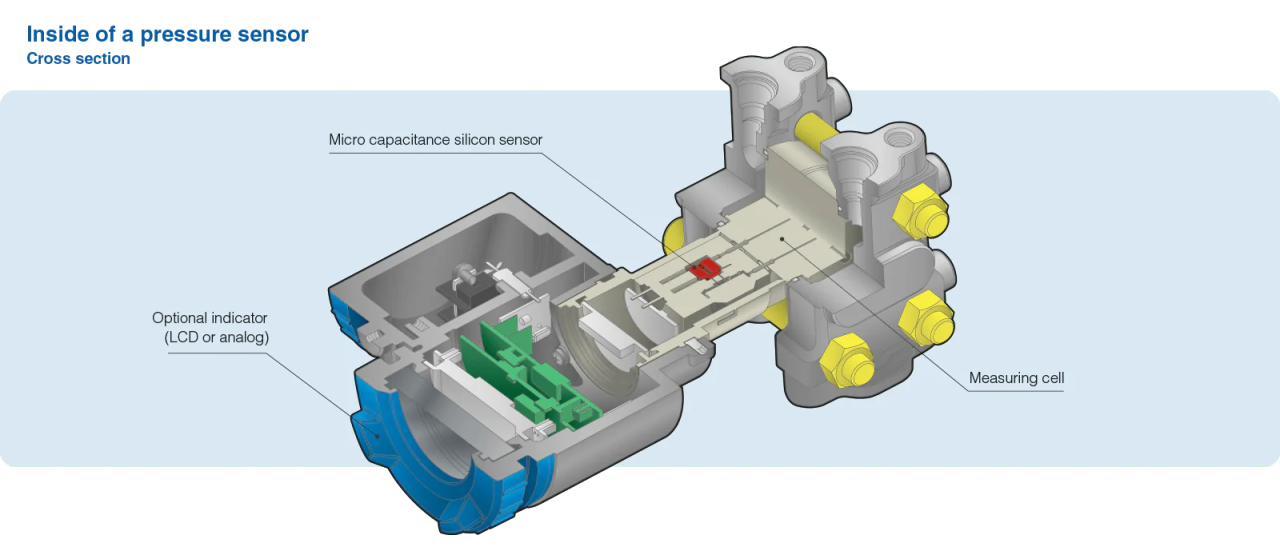
Construction of the pressure transmitter
The construction of a pressure transmitter comprises several essential elements:
- a mechanical connector for mounting
- a metallic or ceramic membrane
- a capacitive sensor or piezoresistive detector
- a filling fluid, often oil, integrated into the pressure cells to transmit pressure variations
- electronic module for conditioning and amplifying the detector signal
- an electrical connector for easy connection to other automation systems
- a plastic or metal housing (aluminum, stainless steel, stainless steel)
- a digital indicator (optional) to display pressure information in real time

What is the output signal of an industrial pressure transmitter ?
The signal from a pressure sensor can be either analog or digital. The analog signal from pressure transmitter is usually a 4-20mA current output, a 0-10V voltage output or a 1-5V voltage output. The output signal is sent to the control unit in order to act on the control unit.
The 4-20mA analog output signal is commonly used by these devices because of the many advantages it offers.
First of all, the pressure transmitter 4-20 mA is resistant to signal loss due to the transmission line, guaranteeing accurate measurement.
It also extends the distance between pressure transmitter and the system concerned. In addition, the absence of current makes it possible to detect line faults, facilitating troubleshooting. The 4-20mA 2-wire or 4-wire pressure transmitter is also less sensitive to electromagnetic interference, which guarantees its reliability.
Finally, it can be used in a 4-20mA loop to power several devices such as the display, controller and recorder.

Digital communication is available with various communication protocols - HART - Fieldbus - Profibus - Modbus. These communication protocols not only transmit the measured value, but also enable pressure measurement devices to be configured. These are known as SMART electronic transmitters. Some pressure transmitters electronic transmitters also offer IO Link interfaces, a range of specific measurement accuracies and ranges, and international approvals.

How to choose an industrial pressure transmitter ?
The industrial pressure transmitter must be selected according to the fluid to be measured, the pressure range and the operating conditions of the application and process.
- Properties of the fluid to be measuredsuch that : pressure transmitter air, pressure transmitter gas, pressure transmitter hydrogen, pressure transmitter steam, pressure transmitter water or other liquid, as well as its characteristics (density, viscosity, corrosivity, etc.).
- Process operating conditions: pressure to be measured, static pressure, process temperature, risk of corrosion
- The type of measurement: pressure measurement, Differential Pressure (DP) flow measurement, hydrostatic level measurement, density measurement
- The type of pressure to be measured:
- Gauge pressure
- Atmospheric pressure
- Absolute pressure
- differential pressure
- Barometric pressure

RELATED ARTICLES
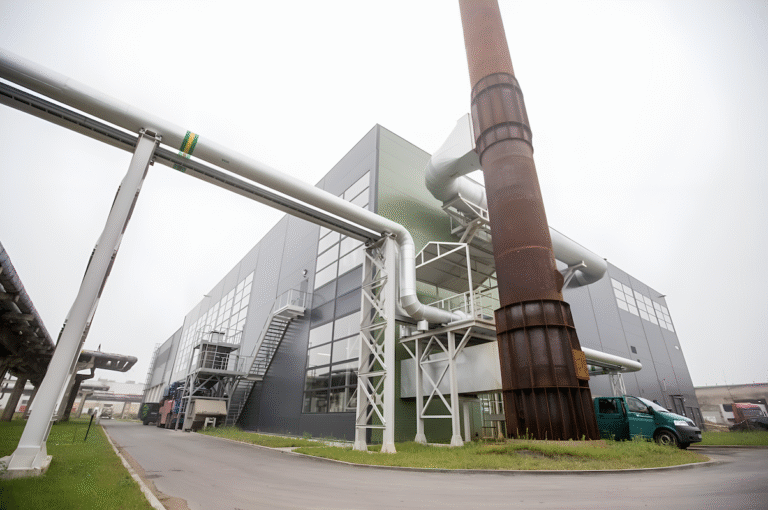
New VACON 100 FLOW 250 kW inverter at Foxita power plant
The company Invertas, UAB successfully implemented another technological project – installed, programmed and launched a VACON 100 FLOW 250 kW frequency converter...
More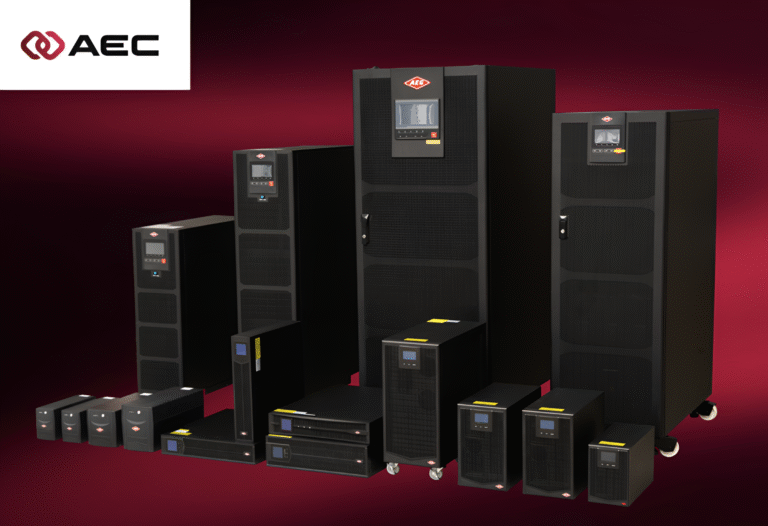
Invertas became the official representative of AEC International UPS in Lithuania
Invertas is proud to have become the official representative of AEC International – one of the most famous uninterruptible power supply (UPS) manufacturers in Europe – in Lithuania. This cooperation...
More